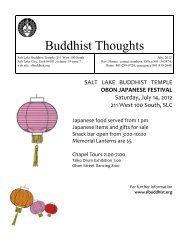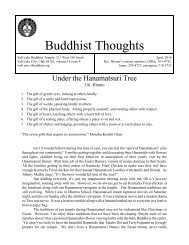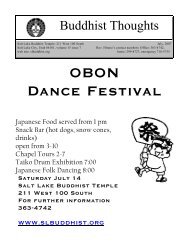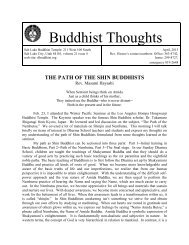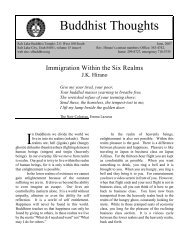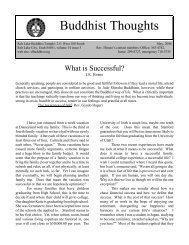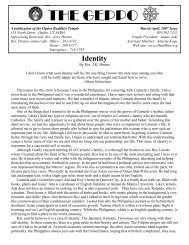Buddhism in a Nutshell - Salt Lake Buddhist Temple
Buddhism in a Nutshell - Salt Lake Buddhist Temple
Buddhism in a Nutshell - Salt Lake Buddhist Temple
Create successful ePaper yourself
Turn your PDF publications into a flip-book with our unique Google optimized e-Paper software.
m<strong>in</strong>d with penetrat<strong>in</strong>g wisdom.The emphasis on “heart feel<strong>in</strong>g” <strong>in</strong> Sh<strong>in</strong> <strong>Buddhism</strong> is greater than that of otherforms of <strong>Buddhism</strong>. For nearly 800 years it has been devoted to provid<strong>in</strong>g lay peoplewith a way <strong>in</strong> which to experience awaken<strong>in</strong>g and joy <strong>in</strong> their own everyday lives.In Sh<strong>in</strong> <strong>Buddhism</strong>, awaken<strong>in</strong>g isn’t someth<strong>in</strong>g we strive for and obta<strong>in</strong> throughour own efforts by study<strong>in</strong>g or meditat<strong>in</strong>g. When our hearts rooted <strong>in</strong> gratitude andawareness of others glow with<strong>in</strong> us, we express our feel<strong>in</strong>gs by say<strong>in</strong>g, “Namo AmidaButsu,” a phrase called the nembutsu. The nembutsu is close to the hearts of every Sh<strong>in</strong><strong>Buddhist</strong>. “Namo Amida Butsu,” are words simple to understand. It translate as “ I takerefuge <strong>in</strong> Amida Buddha.” Amida Buddha is not a creator or a supreme be<strong>in</strong>g. . It is asymbol and has the qualities of compassion and wisdom that we are able to realize <strong>in</strong> ourexperiences of our daily life. Wisdom helps me see myself and life as they really are.Compassion enhances my appreciation for th<strong>in</strong>gs and assures me that I am embraced andnot forsaken. The nembutsu is not a mantra, a prayer, or a practice to generateenlightenment. Our founder, Sh<strong>in</strong>ran, taught that we should th<strong>in</strong>k of nembutsu as thepractice of Amida Buddha, not as our own. When we say the nembutsu, we are allow<strong>in</strong>gAmida’s practice flow through us. Nembutsu is someth<strong>in</strong>g <strong>in</strong> which we participate, notsometh<strong>in</strong>g that we produce. It is someth<strong>in</strong>g we receive from Amida.Sh<strong>in</strong> <strong>Buddhism</strong> is a religion of awareness. Besides be<strong>in</strong>g aware of the basic truthsof life understood by other schools of <strong>Buddhism</strong>, it stresses the need to become awarethat we are imperfect and the greed, ignorance and anger that we possess make uspowerless to realize enlightenment by our own power. Sh<strong>in</strong> <strong>Buddhism</strong> teaches that thesource of our suffer<strong>in</strong>g is cl<strong>in</strong>g<strong>in</strong>g to our ego and the deluded belief that one’s own<strong>in</strong>dividual power is sufficient to overcome the deep resentment, greed, and ignorance thatwe have. We are taught to rely wholly on the Other Power. Giv<strong>in</strong>g up Self-Power isvirtually impossible.Sh<strong>in</strong> teach<strong>in</strong>g is realistic, and it provides assurance of enlightenment. From ourhuman perspective, it is impossible to atta<strong>in</strong> enlightenment, but when we become moreaware of the basic truths of life and our imperfections, we become appreciative for allbe<strong>in</strong>gs and materials that susta<strong>in</strong> and nurture our lives. We come to realize that “life is aprivilege and not a right.” With deeper awareness, we become more concerned andappreciative and work for the betterment of all life. When this awareness leads to atransformation with<strong>in</strong> us, it is called “sh<strong>in</strong>j<strong>in</strong>.”Those hav<strong>in</strong>g “sh<strong>in</strong>j<strong>in</strong>” no longer worry about life after death because they are atpeace with<strong>in</strong> themselves. Accord<strong>in</strong>g to Sh<strong>in</strong>ran, we are assured of realiz<strong>in</strong>g oneness orenlightenment immediately upon death <strong>in</strong> becom<strong>in</strong>g one with the cosmic wisdom andcompassion.<strong>Buddhism</strong> teaches that death is a part of life, and that although none of us canpredict death, we need not worry about the hereafter because we are always embraced <strong>in</strong>the absolute Wisdom and Compassion of Amida Buddha. <strong>Buddhism</strong> emphasizesuniversal life rather than the <strong>in</strong>dividual soul. Heaven and hell are conditions of lifecreated by us here and now and do not denote places after death. To live fully is to beprepared for all events with trust and serenity, and to avoid a morbid preoccupation withdeath and concern about what will take place when we die. Death clarifies life’s truths.Dy<strong>in</strong>g is part of the human condition. To live decently and then serenely leave the worldis total fulfillment.



